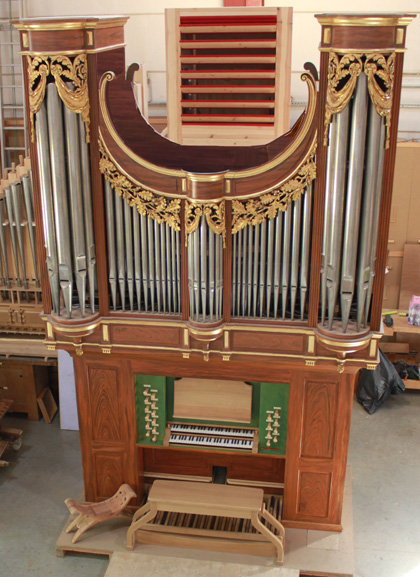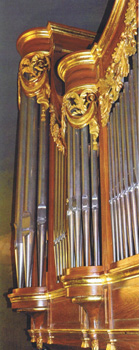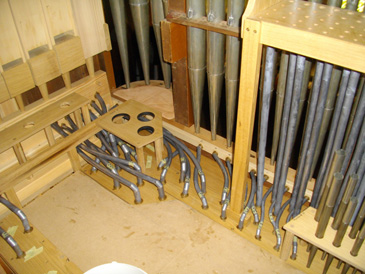

Organ : 2 keyboards , pedalboard - 17 stops

The temple of Prilly dates of the XVIIIth century and was provided with an organ of Joseph Mooser in 1823. From this instrument, it still exists the front part of the case, the elegant style of which is typical of the Mooser's organs, with very beautiful golden wooden fences which remained in a perfect state of preservation.
On the occasion of the temple's reorganization, at the beginning of the XXth century, the company Kuhn reconstructed the organ in 1926, which is the current instrument.
The case of Mooser, wich is only 47 cms depth, was stuck to the bottom wall of the temple. The organ of Mooser was to be inevitably deeper originally, and in a position more close to the edge of the gallery.
The organ works with tubular pneumatic action, and an impressive separate console appears as a wart in front of the beautiful facade of Mooser. The pneumatic system allows to play 4 stops on one or the other keyboard, so that 13 manual stops are only 9 in reality.

Composition :
| Grand-Orgue - 56 notes | Récit expressif - 56 notes | Pédale - 30 notes |
| Montre 8' | Bourdon 8' | Sous-basse 16' |
| Flûte 8' | Salicional 8' | Flûte 8' |
| Prestant 4' | Voix céleste (du 2ème Do) 8' | Basson 16' |
| Doublette 2' | Flûte 4' | |
| Fourniture III-IV rangs | Nazard 2 2/3' | |
| Cornet III ou V (du 3ème Do) rangs | Flageolet 2' | |
| Trompette 8' | Basson-Hautbois 8' |
Couplers REC/G.O. - G.O./PED - REC/PED - Tremulant

Restoration 's works:
Case:
The renovated instrument must be provided with mechanical action, for it a real reconstruction of the instrument is necessary, the conception of an organ with slider windchests and direct mechanical action being very different from the one who governs an organ entirely pneumatic.
The new console is thus a built-in console, under the Mooser's facade, what implies the construction of a new lower case, allowing the integration of this console at a reasonable height.
Also, the modification of the organ's position on the gallery allows to reconstitute a real case with its sides and its back. These new parts are painted in forgery-wood like it is on the Mooser's facade.

Action and windchests:
The mechanics is suspended for the big organ, and the pedal.
The conception of the windchests resumes that of the former windchests executed in a massive block. There is thus neither added table, nor frame forming the grid, nor bars, nor bearers, these being carved in the massif. These windchests also contain no gluing.